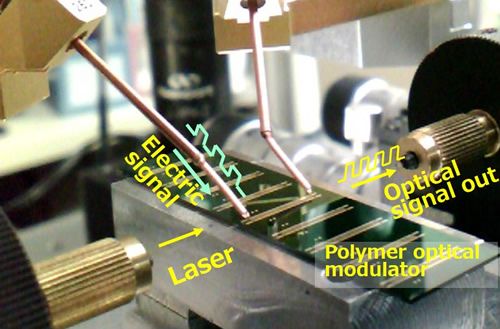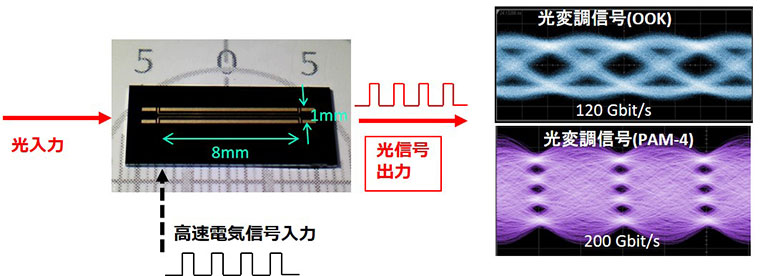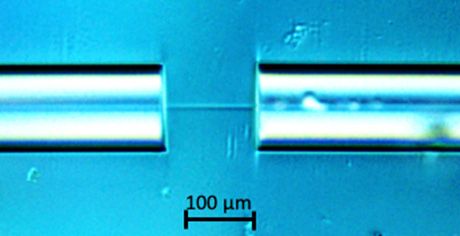Research Results
Expected to contribute to speed improvement, power saving, and cost reduction for optical communication equipment in the era of data explosion
Achievement of the world’s fastest data transmission by a “polymer optical modulator”FY2020

- Yokoyama Shiyoshi(Professor, Institute for Materials Chemistry and Engineering, Kyushu University)
- S-Innovation
- Strategic Promotion of Innovative Research and Development
Development of advanced information communications technology using photonics polymer
Researcher, Optical interconnect device technology using high-performance photonics polymers (2015 ‒ 2018) - Sugihara Okihiro(Professor, Department of Optical Engineering, Graduate School of Engineering, Utsunomiya University)
- S-Innovation
- Strategic Promotion of Innovative Research and Development
Development of advanced information communications technology using photonics polymer
Project Manager, Optical interconnect device technology using high-performance photonics polymers (2009 ‒ 2018)
Success in the development of a “polymer optical modulator,” which has been said to be difficult to put into practical application
With the recent dramatic increase in information communication traffic, there is a demand for more sophisticated communication equipment and for a drastic reduction in power consumption. There is also a demand for a cost reduction for high-speed data transmission technology for data centers. An optical modulator made of an organic polymer material, instead of a conventional inorganic material, has been expected as a new technology that would meet these demands. An optical modulator is a device that utilizes an electro-optic property* to convert an electrical signal to an optical signal at high speed. Such conversion from an electrical signal to an optical signal allows for high-speed transmission of large amount of information. Previously, it has been said that the polymer optical modulator would be difficult to put into practical application due to the materials disadvantage such as low thermal stability.
To address this issue, Professor Yokoyama Shiyoshi’s research group developed a polymer that has an excellent electro-optic property and excellent thermal stability jointly with Nissan Chemical Industries, Ltd. (the present Nissan Chemical Corporation) under the Strategic Promotion of Innovative Research and Development Program (S-Innovation), which is served by Professor Sugihara Okihiro as research leader. Moreover, the research group used the polymers to develop waveguide device of an ultra-high-speed optical modulator jointly with Adamant Namiki Precision Jewel Co., Ltd. As a result, ultra-high-speed optical data transmission that has been hardly enabled by using previous modulators, as well as thermal stabilization and low-voltage driving of the device was successfully achieved for the first time worldwide in May 2018.
Although S-Innovation ended in fiscal 2018, research group is adopted by SICORP (Strategic International Collaborative Research Program) from fiscal 2018 and by A-STEP (Adaptable and Seamless Technology transfer Program through target-driven R&D) from fiscal 2019. Currently, the group is seeking to apply the polymer optical modulator to silicon optical integration technology. It is expected that this approach will contribute to the improvement of the operating speed of optical communication technologies in various industrial applications, including data centers and IoT, as well as to power saving and cost reduction.
* A phenomenon in which application of voltage to a material causes a change in the refractive index of light is called an electro-optic effect, and the property of such substance is called an electro-optic property.

Figure 1 Ultra-high-speed optical modulator made of an electro-optic polymer. A laser light input to the polymer optical modulator is modulated by a high-speed electrical signal, whereby an ultra-high-speed optical signal is transmitted.
Urgent need to develop optical communication technology capable of accommodating a rapid increase in data transmission volume
Currently, a standard technology known as Ethernet is primarily used for wired computer networks. In Ethernet-compliant networks, an electrical signal is converted to an optical signal at high speed for optical transmission, and transmission speed is increasing year by year. The rate of increase reached 400% in the past 20 years. It is based on the improvement of channel speed of optical modulators. Since one optical modulator can transmit the limited amount of information, information with a transmission rate of more than 100 gigabits per second is processed by using multiple optical modulators in parallel. 100 Gigabit Ethernet*, which is a leading-edge technology, offers 4–16-channel parallel transmission, thereby contributing to an increase in transmission capacity. The introduction of 400 Gigabit Ethernet has just been started, and 800 Gigabit Ethernet, the next-generation standard technology, has begun to be discussed. These situations have created an urgent need to develop a short-distance transmission system that can accommodate a rapid increase in data transmission volume and optical communication equipment that support the system.
In these circumstances, there have recently been growing expectations for an optical modulator made of a polymer with an electro-optic property on a global basis. Compared to the previous optical modulators composed of existing inorganic materials such as lithium niobate or semiconductor materials, polymer optical modulator theoretically promises significantly higher speed potential, further drawing attention in terms of power consumption and manufacturing cost as well. For this reason, ultra-high-speed optical data transmission with a polymer optical modulator has been reported worldwide heretofore; however, there have been challenges to overcome in order to put it into practical application.
* Computer network standard with a baud rate of gigabit/second order (giga = one billion)
The world’s first achievement of ultra-high speed, power saving and cost reduction
It is suggested that the electrooptic polymer theoretically has a responsiveness of 100 gigahertz or higher. This means that it can realize such ultra-high-speed data transmission that cannot be achieved by optical modulators made of an inorganic material or a semiconductor material.
In light of this, Professor Yokoyama’s research group was quick to focus attention on an electro-optic polymer material with a property of changing the refractive index of light in response to voltage application. Jointly with Nissan Chemical, the group has been implementing design and synthesis of a high-performance polymer, solution of issues toward reliability improvement, prototyping of an optical modulator, and a study of performance evaluation. As a result, they successfully developed a polymer with high optical properties and excellent thermal stability and integrated it into a device. Moreover, jointly with Adamant Namiki Precision Jewel, the group fabricated a polymer optical modulator and as a result, successfully accomplished a demonstration of ultra-high-speed optical data transmission for the first time worldwide.
Actually, analysis of the high-frequency responsivity of this polymer modulator demonstrated that the modulator had a 2–3 fold frequency responsiveness, compared to crystals of conventional inorganic materials, such as lithium niobite, and that it was able to perform ultra-high-speed optical signal of more than 100 gigabits per second at a low operating voltage on the order of 1 volt. This achievement is expected as a technology leading to drastic power saving of communication equipment. In addition, since the polymer optical modulator can be fabricated with a simple coating technique, it can be integrated with silicon optical integration technology, thus enabling a drastic cost reduction taking advantage of smaller footprint.
Specifically, in an optical transmission experiment that used the polymer optical modulator, an optical signal of 112 gigabits per second was successfully generated. Moreover, it was confirmed that the operating voltage of the optical modulator was regulated at 1.5 volts.
Moreover, based on their prediction that various sensors to be installed in self-driving vehicles in the future would need to process huge amounts of information for ensuring safe driving, the research group conducted a project for development of an in-vehicle optical modulator. As a result, the group succeeded also in synthesizing an electro-optic polymer with a glass transition temperature of 190ºC or higher. Thus, thermal stability at 105ºC, an index of thermal resistance of in-vehicle equipment, was cleared, so as to overcome the challenge concerning the thermal stability of optical modulators.

Figure 2 Photograph of the electro-optic polymer modulator fabricated in this study and graphics of the respective modulation characteristics of the OOK (On-Off keying) and PAM-4 (4-level pulse amplitude modulation) schemes (upper: OOK scheme; lower: PAM-4 scheme). The present research succeeded in generating a 100-Gbps optical signal by using the OOK scheme and a 112-Gbps optical signal by using the PAM-4 scheme (the result for the OOK scheme is the one obtained after the research was further implemented under SICORP). It can be expected that a high-speed electrical signal is input to the electrode part, whereby the signal is converted to an optical signal so as to be applied to transmission via an optical fiber or on-board signal processing.
Pursuit of implementation into optical communication equipment
In their approach to the practical application of the polymer optical modulator, the research group succeeded also in connecting light-receiving and light-emitting devices with an optical fiber playing a role in information transmission. A series of tasks concerning connection technology, starting from material development, were carried out mainly by Utsunomiya University and Toyota Central R&D Labs, Inc. They developed a monomer material that polymerizes when subjected to near-infrared light. They found that the polymerization reaction occurred upon irradiation of an optical fiber placed in a solution of this monomer material with near-infrared light, enabling it to be automatically connected to the optical fiber. This is automatic connection technology; hence, it can contribute to a drastic reduction in assembly cost.
Moreover, since the polymer optical modulator can be fabricated with a simple coating technique, it can be integrated with silicon optical integration technology and is expected to contribute also to the creation of small-size, ultra-high-speed and low-power-consumption new optical technology. In anticipation of a future growing demand for processing huge amounts of information in relation to data centers, self-driving vehicles, artificial intelligence, IoT and so forth, the research group is currently trying to incorporate the polymer material into optical communication equipment.


Figure 3 Microphotograph of light-induced self-written waveguide interconnection formed by using 1.55-micrometer near-infrared light
The use of this technology is not limited to automatic interconnection between single-mode optical fibers; it can also be applied to waveguide growth from a near-infrared light source and silicon photonics interconnection.
